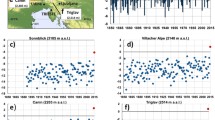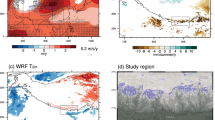Abstract
The analysis of satellite images revealed by 25% decrease of the Altai mountains’ glaciation area over last 50 years. In 2008–2017, deglaciation rate increased twice. This tendency is in good agreement with an observed increase in the Katun River flow by 9% in 2008–2017 as compared to 1940–1968 (under invariable total precipitation). The analysis of trends of main meteorological parameters based on weather station data and the ERA-Interim reanalysis demonstrated that statistically significant warming in the region occurs only during the warm season and does not exceed 0.5°С/10 years. For this reason, “atmosphere–glaciers” turbulent heat transfer has increased by 4 W/m2 in last two years, that caused an annual melting layer increase by 100 mm water equivalent (w.e.). However, the main reason for the Altai mountains’ deglaciation is an increase of downward solar radiation flux, which amounted to 5 W/m2 per decade and increased the melting layer by 365 mm w.e. per year. A positive trend in net radiation agrees well with a decrease in cloud amount, which is associated with an increase in the moisture divergence flux and geopotential height and with the weakening of zonal winds in the middle troposphere.


Similar content being viewed by others
REFERENCES
M. A. Aleshina, P. A. Toropov, and V. A. Semenov, “Temperature and Humidity Regime Changes on the Black Sea Coast in 1982–2014,” Meteorol. Gidrol., No. 4 (2018) [Russ. Meteorol. Hydrol., No. 4, 43 (2018)].
The Global Atlas of Snow and Ice Resources (RAN, Moscow, 1997) [in Russian].
M. Yu. Bardin, T. М. Platova, and O. F. Samokhina, “Variability of Anticyclone Activity in the Northern Extratropics,” Fundamental’naya i Prikladnaya Klimatologiya, No. 3 (2019) [in Russian].
A. P. Voloshina, “Meteorology of Mountain Glaciers,” Materialy Glyatsiologicheskikh Issledovanii, No. 92 (2002) [in Russian].
The Catalog of the USSR Glaciers, Vol. 15, Issue 1, Part 4 (Gidrometeoizdat, Leningrad, 1977) [in Russian].
S. A. Nikitin, “Glacier Ice Distribution Patterns in the Russian Altai, Estimation of Ice Reservoirs and Dynamics,” Materialy Glyatsiologicheskikh Issledovanii, No. 107 (2009) [in Russian].
G. A. Nosenko, A. Ya. Murav’ev, M. N. Ivanov, A. I. Sinitskii, V. O. Kobelev, and S. A. Nikitin, “Current State and Changes in the Polar Urals Glaciers in 2000–2018,” Led i Sneg, No. 1 (2020) [in Russian].
G. A. Nosenko, S. A. Nikitin, and T. E. Khromova, “Glacier Area and Volume Changes in the Altai Mountains (Russia) since the Mid-twentieth Century as Inferred from Satellite Data,” Led i Sneg, No. 2, 54 (2014) [in Russian].
O. P. Osipova, “Quantification of the Atmospheric Circulation Intensity in Southern Eastern Siberia,” Geografiyai Prirodnye Resursy, No. 1 (2011) [in Russian].
V. D. Panov,TheCaucasus Glaciation Evolution (Gidrometeoizdat, St. Petersburg, 1993) [in Russian].
V. M. Plyusnin, E. N. Ivanov, A. D. Kitov, and V. S. Sheinkman, “The Dynamics of Contemporary Glaciers in the Mountains of the South of Eastern Siberia,” Geografiya I Prirodnye Resursy, No. 3 (2017) [in Russian].
V. V. Popova, “Modern Climate Change in Northern Eurasia as a Manifestation of Variations in Large-scale Atmospheric Circulation,” Fundamental’naya i Prikladnaya Klimatologiya, No. 1 (2018) [in Russian].
V. A. Semenov, “Link between Anomalously Cold Winters in Russia and Sea-ice Decline in the Barents Sea,” Izv. Akad. Nauk, Fiz. Atmos. Okeana, No. 3, 52 (2016) [Izv., Atmos. Oceanic Phys., No. 3, 52 (2016)].
P. A. Toropov, V. N. Mikhalenko, S. S. Kutuzov, P. A. Morozova, and A. A. Shestakova, “Temperature and Radiation Regime of Glaciers on the Mount Elbrus Slopes during the Ablation Period over the Last 65 Years,” Led i Sneg, No. 1, 56 (2016).
P. A. Toropov, A. A. Shestakova, A. M. Smirnov, and V. V. Popovnin,“Evaluation of the Components of the Heat Balance of the Djankuat Glacier (the Central Caucasus) during the Period of Ablation in 2007–2015,” Kriosfera Zemli, No. 4, 22 (2018) [Earth’s Cryosphere, No. 4,22 (2018)].
R. G. Barry,Mountain Weather and Climate (Cambridge University Press, London, 2008).
M. R. Broeke, “Momentum, Heat and Moisture Budgets of Katabatic Wind Layer over Midlatitude Glacier in Summer,” J. Appl. Meteorol., No. 6,36 (1997).
D. P. Dee, S. M. Uppala, A. J. Simmons, P. Berrisford, P. Poli, S. Kobayashi, U. Andrae, M. A. Balmaseda, G. Balsamo, P. Bauer, P. Bechtold, A. C. M. Beljaars, L. van de Berg, J. Bidlot, N. Bormann, C. Delsol, R. Dragani, M. Fuentes, A. J. Geer, L. Haimberger, S. B. Healy, H. Hersbach, E. V. Hylm, L. Isaksen, P. Kellberg, M. Kohler, M. Matricardi, A. P. McNally, B. M. Monge-Sanz, J.-J. Morcrette, B.-K. Park, C. Peubey, P. de Rosnay, C. Tavolato, J.-N. Thepaut, and F. Vitart, “The ERA-Interim Reanalysis: Configuration and Performance of the Data Assimilation System,” Quart. J. Roy. Meteorol. Soc., No. 656,137 (2011).
D. R. Hardy, M. Vuille, and R. S. Bradley, “Variability of Snow Accumulation and Isotopic Composition on Nevado Sajama, Bolivia,” J. Geophys. Res., Atmos., No. D22, 108 (2003).
I. P. D. J. Harris, P. D. Jones, T. J. Osborn, and D. H. Lister, “Updated High-resolution Grids of Monthly Climatic Observations––The CRU TS3. 10 Dataset,” Int. J. Climatol., No. 3, 34 (2014).
R. Hock, G. Rasul, C. Adler, B. Caceres, S. Gruber, Y. Hirabayashi, M. Jackson, A. Kaab, S. Kang, S. Kutuzov, A. Milner, U. Molau, S. Morin, B. Orlove, and H. Steltzer, “High Mountain Areas,” in IPCC Special Report on the Ocean and Cryosphere in a Changing Climate (The Intergovernmental Panel on Climate Change (IPCC), 2019).
M. Honda, J. Inoue, and S. Yamane, “Influence of Low Arctic Sea-ice Minima on Anomalously Cold Eurasian Winters,” Geophys. Res. Lett., No. 8, 36 (2009).
M. Huss and R. Hock, “A New Model for Global Glacier Change and Sea-level Rise,” Frontiers in Earth Science, 3 (2015).
M. Huss, R. Hock, A. Bauder, and M. Funk, “100-year Mass Changes in the Swiss Alps Linked to the Atlantic Multidecadal Oscillation,” Geophys. Res. Lett., No. 10, 37 (2010).
J. Liu, J. A. Curry, H. Wang, M. Song, and R. M. Horton, “Impact of Declining Arctic Sea Ice on Winter Snowfall,” Proc. Nat. Acad. Sci., No. 11, 109 (2012).
J. Lu, G. A. Vecchi, and T. Reichler, “Expansion of the Hadley Cell under Global Warming,” Geophys. Res. Lett., No. 6, 34 (2007).
A. M. Milner, K. Khamis, T. J. Battin, J. E. Brittain, N. E. Barrand, L. Fureder, S. Cauvy-Fraunie, G. Gislason, D. Jacobsen, D. Hannah, A. Hodson, E. Hood, V. Lencioni, J. Olafsson, C. Robinson, and M. Tranter, “Glacier Shrinkage Driving Global Changes in Downstream Systems,” Proc. Nat. Acad. Sci., No. 37, 114 (2017).
T. Molg, N. J. Cullen, D. R. Hardy, M. Winkler, and G. Kaser, “Quantifying Climate Change in the Tropical Midtroposphere over East Africa from Glacier Shrinkage on Kilimanjaro,” J. Climate, No. 15, 22 (2009).
F. Paul, N. E. Barrand, S. Baumann, E. Berthier, T. Bolsh, K. Casey, H. Frey, S. P. Joshi, V. Konovalov, R. le Bris, N. L. Moe, G. Nosenko, C. Nut, A. Pope, A. Racoviteanu, P. Rastner, B. Raup, K. Scharrer, S. Steffen, and S. Winsvold, “On the Accuracy of Glacier Outlines Derived from Remote-sensing Data,” Ann. Glaciol., No. 63, 54 (2013).
D. S. Permana, L. G. Thompson, E. M. Thompson, M. E. Davis, P.-N. Lin, J. P. Nicolas, J. F. Bolzan, B. W. Bird, V. N. Mikhalenko, P. Gabrielli, V. Zagorodnov, K. R. Mountain, U. Schotterer, W. Hanggoro, M. N. Habibie, D. Kaize, and G. S. Gunawan, “Disappearance of the Last Tropical Glaciers in the Western Pacific Warm Pool (Papua, Indonesia) Appears Imminent,” Proc. Nat. Acad. Sci., No. 52,116 (2019).
R. Philipona, A. Krauchi, and E. Brocard, “Solar and Thermal Radiation Profiles and Radiative Forcing Measured through the Atmosphere,” Geophys. Res. Lett., No. 13, 39 (2012).
A. Rabatel, B. Francou, A. Soruco, J. Gomez, J. L. Ceballos, R. Basantes, and C. Huggel,“Current State of Glaciers in the Tropical Andes: A Multi-century Perspective on Glacier Evolution and Climate Change,” The Cryosphere (2017).
V. A. Semenov and M. Latif, “Nonlinear Winter Atmospheric Circulation Response to Arctic Sea Ice Concentration Anomalies for Different Periods during 1966–2012,” Environ. Res. Lett., No. 5, 10 (2015).
V. A. Semenov, M. Latif, J. H. Jungclaus, and W. Park, “Is the Observed NAO Variability during the Instrumental Record Unusual?”, Geophys. Res. Lett., No. 11,35 (2008).
M. Shahgedanova, G. Nosenko, T. Khromova, and A. Muraveyev, “Glacier Shrinkage and Climatic Change in the Russian Altai from the Mid-20th Century: An Assessment Using Remote Sensing and PRECIS Regional Climate Model,” J. Geophys. Res., Atmos., No. D16, 115 (2010).
E. Thibert, P. Dkengne Sielenou, V. Vionnet, N. Eckert, and C. Vincent, “Causes of Glacier Melt Extremes in the Alps since 1949,” Geophys. Res. Lett., No. 2, 45 (2018).
P. A. Toropov, M. A. Aleshina, and A. M. Grachev, “Large-scale Climatic Factors Driving Glacier Recession in the Greater Caucasus, 20th–21st Century,” Int. J. Climatol., 39 (2019).
V. Zaginaev, D. Petrakov, S. Erokhin, A. Meleshko, M. Stoffel, and J. A. Ballesteros-Canovas, “Geomorphic Control on Regional Glacier Lake Outburst Flood and Debris Flow Activity over Northern Tien Shan,” Glob. Planet. Change, 176 (2019).
M. Zemp, E. Huss, E. Thibert, N. Ecket, R. McNabb, J. Huber, M. Barandun, H. Machguth, S. Nuddbaumer, I. Gartner-Roer, L. Thomson, F. Paul, F. Maussion, S. Kutuzov, and J. Cogley, “Global Glacier Mass Changes and Their Contributions to Sea-level Rise from 1961 to 2016,” Nature, 568 (2019).
Funding
The estimation of the Altai glaciation trends was performed in the framework of the Governmental Assignment theme 0148-2019-0004, the calculation of trends in meteorological parameters was carried out in the framework of the Governmental Assignment theme 0148-2019-0009, the analysis and interpretation of results, as well as the estimates of the contribution of the radiation factor to the deglaciation was supported by the Russian Foundation for Basic Research (grant 20-05-00176).
Author information
Authors and Affiliations
Corresponding author
Additional information
Russian Text ©The Author(s), 2020, published in Meteorologiya i Gidrologiya, 2020, No. 5, pp. 118–130.
About this article
Cite this article
Toropov, P.A., Aleshina, M.A., Nosenko, G.A. et al. Modern Deglaciation of the Altai Mountains: Effects and Possible Causes. Russ. Meteorol. Hydrol. 45, 368–376 (2020). https://doi.org/10.3103/S1068373920050088
Received:
Revised:
Accepted:
Published:
Issue Date:
DOI: https://doi.org/10.3103/S1068373920050088




